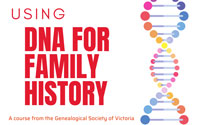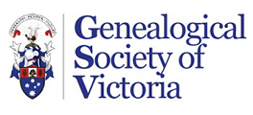Live Presentations on Zoom
During the year we present a series of live presentations on ZOOM covering a range of topics on genetic genealogy. These will be from beginner to more intermediate topics. These sessions allow for for online questions and discussion. We hope this will make GSV’s presentations more available to members unable to travel and to regional members.
Check the GSV events calendar for sessions.
Using DNA for Family History - Course Outline 2025
 If you have tested your DNA with Ancestry and wish to learn some basic techniques for effectively working with your match lists to confirm your family tree and solve its mysteries, then this is the course for you.
If you have tested your DNA with Ancestry and wish to learn some basic techniques for effectively working with your match lists to confirm your family tree and solve its mysteries, then this is the course for you.
The seven session course will begin on Wednesday 12 March 10am-12pm and continue monthly from May to October. Meeting over Zoom, Maureen Trotter will lead sessions providing ample time for questions and discussion. The course is run as a progression of classes which should be completed consecutively, but can be taken as one off events for those who need a refresher on that topic.
The presentation from each session will be recorded and the recording made available to participants for a month after the session.
A Facebook group is available to support group discussion and learning for the duration of the course.
Each session will cost $20 for members and $40 for non-members. To register for a session click on the Register link next to the title of the course outline below:
Course Outline
-
Exploring our DNA results - Wed 12 Mar, 10am-12pm Register
In this session, we will explore some of the many genealogical treasures included with our Ancestry DNA results and learn how to navigate and make sense of the many sets of information included.
-
Shared Matches: Our Connection to Cousins – Wed 14 May, 10am-12pm Register
Our DNA match lists connect us to thousands of people who share DNA with us. Some of these people are known, close family members, but most are distant cousins. In this session, we will explore how shared DNA, relationship estimate tools and family trees can help us work out how we are related to many of these cousins. We will also consider what to do if our DNA results reveal unexpected relationships.
-
Clustering DNA Matches - Wed 11 June, 10am-12pm Register
In this session, you will learn two easy methods of organising your DNA match list so that groups of related people are easily identified.
-
Research Objectives and Tree Building – Wed 9 July, 10am-12pm Register
Whether we want to confirm a section of our tree or solve a family mystery, having a specific research objective helps us focus on the relevant cluster of matches. In this session, you will learn how to set up a private and unsearchable research tree and use it to build trees for your matches, then look for connections between them.
-
Confirming your Tree and Solving Mysteries – Wed 13 August, 10am-12pm Register
Learn how to solve more complex family mysteries by effectively using all of Ancestry’s hints systems, including Thrulines, building research trees and charts for clusters of DNA matches, as well as lots of traditional genealogical research.
-
Digging Deeper - 10 September, Wed 10am-12pm Register
In this session, we will investigate some of the many innovative tools and techniques that have been developed to enhance our DNA research, how to upload DNA to other sites, and how to keep track of matches when managing multiple kits and across the various testing companies.
-
Sharing your progress – Wed 8 October, 10am-12pm Register
How will you share your progress findings? In your online tree, WikiTree, FamilySearch tree, formal research report, article for Ancestor, message to cousins, comment on other trees, or not at all? In this session, we will look at a number of these possibilities. As constructive feedback is always helpful, time will be available for you to share your progress so far.
DNA Genetic Genealogy Study Group
Convenor: Maureen Trotter. This new group is for intermediate to advanced genetic genealogy users. It is a self help group for people who are familiar with DNA terminology and available software tools, and who would like to work in a small study group where participants meet to continue to hone their skills in genetic genealogy. Participants will have completed the GSV DNA for beginners classes or have a similar knowledge base. The study group will meet on the first Tuesday of the month, 10.00am to 12.00pm. Maximum attendees of 14 per meeting.
DNA email - dna@gsv.org.au is available to support participants of the talks and study group.
DNA Consultations
At present the GSV does not offer DNA Consultations.
